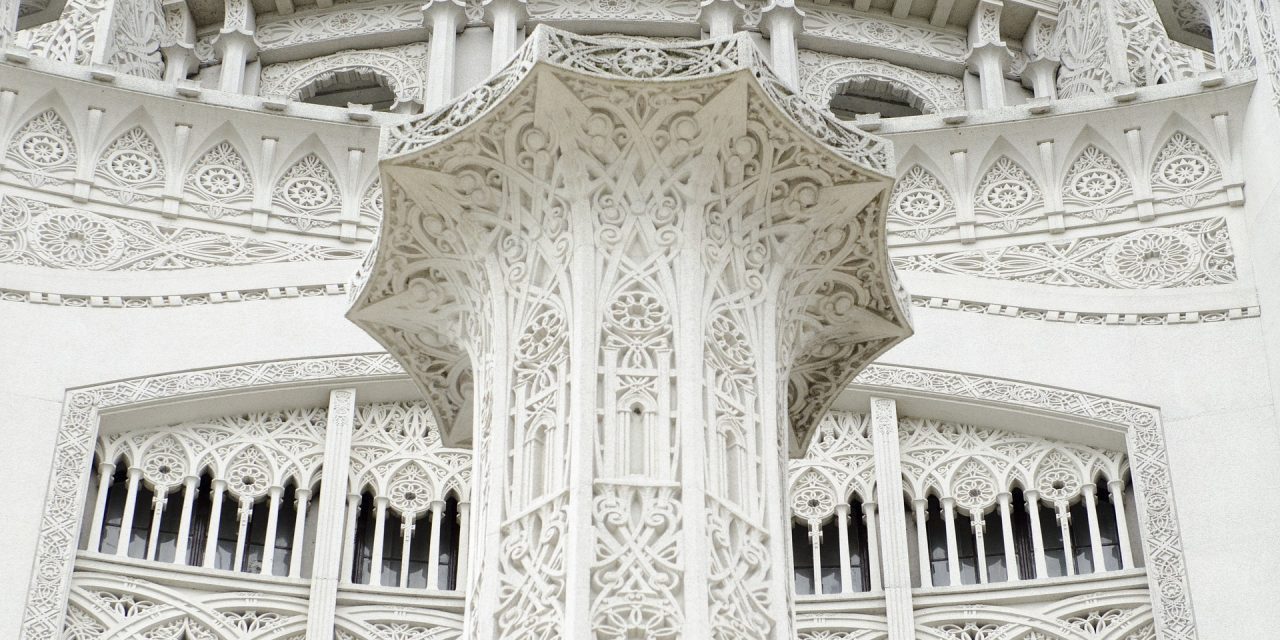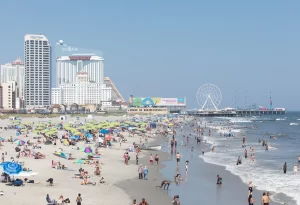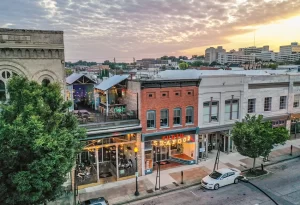Infuse your Illinois itineraries with spiritual enlightenment at noteworthy houses of worship, historical sites, inspirational landmarks, and religious shrines and museums
There it stands as a beacon of hope and assurance, soaring nearly 200 feet into the Midwestern sky at an unlikely location—the intersection of Interstates 57 and 70 in Effingham, Illinois. Welcoming thousands of passing motorists every day, America’s biggest cross is a sight to behold, especially when illuminated at night.
In southwestern Illinois, at the country’s largest Marian shrine, groups experience the meaning of the season on a drive through the largest faith-based outdoor Christmas display anywhere. Only a half-hour away awaits another enlightening sacred site, a collection of earthen mounds from an ancient sun-worshipping Indian community that’s been called the City of the Sun.
In suburban Chicago, in the dimly lit rotunda of a nationally known museum of Christian evangelism, a disc of light on the floor welcomes visitors with the message, “I am the light of the world. Whoever follows me will never walk in darkness but will have the light of life” (John 8:12). Blessed with many places of religious interest and many points of light, Illinois makes a heavenly destination for faith groups or any group wishing to add a spiritual component to its travels.
Groups that get off the interstate at Exit 159 in Effingham will find The Cross at the Crossroads, a peaceful spot where those of all faiths and backgrounds can pause and reflect, even amid the roar of traffic. Travelers marvel at the sheer size of this engineering wonder, a 20-story structure of white steel whose arms span 113 feet. Surrounded by a grassy field, its base is ringed by polished granite tablets representing the Ten Commandments, with push-button audio messages at each station. The visitor center has a chapel and shows an eight-minute video on the Cross’s construction and dedication on September 16, 2001 (just five days after the September 11 terrorist attacks that shook the country). The non-denominational site is a project of The Cross Foundation, a local, not-for-profit organization.
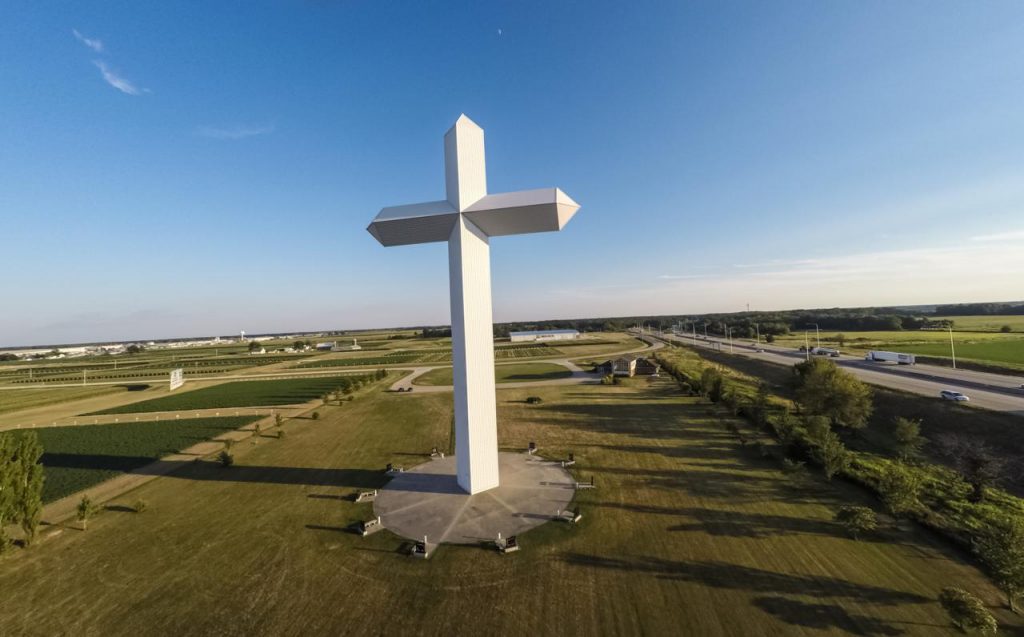
The Cross at the Crossroads draws the attention of motorists passing through Effingham.
Credit: Effingham CVB
Bald Knob Cross of Peace, another colossal white cross, crowns a mountaintop in Shawnee National Forest near the small town of Alto Pass in southern Illinois, southwest of Carbondale. Illuminated at night, the 111-foot landmark (with arms measuring 63 feet wide) is visible throughout an area covering 7,500 square miles. Completed in 1963, it was renovated from 2009-2011. Special events include an Easter sunrise service.
Teutopolis, a little town just minutes from Effingham, is home to the Monastery Museum, which tells the story of the Franciscan friars who came from Germany in 1858 to serve German-speaking immigrants. Attached to St. Francis of Assisi Church, the building was a novitiate, a place of housing for novices (men in training for the Catholic priesthood, prior to taking their vows). The one-person bedrooms (or cells) flanking the long corridors have exhibits on the life of the monastery and community. Of special note is the 62-spool machine that wove yarn into the cords worn around the friars’ waists. Other displays showcase costumes, beer steins and other items that reflect the pioneer past and German heritage of Teutopolis (“City of the Teutons”). Group tours include a video on church and town history, the mausoleum where 79 friars are buried and the grand finale, beautiful St. Francis of Assisi Church with its stained glass windows depicting the life of St. Francis.
The National Shrine of Our Lady of the Snows in Belleville, another place special to Catholics, has four miles of roads threading 200 hilltop acres overlooking the Mississippi River Valley. Christmastime’s Way of Lights drive-through display attracts groups of all faiths from mid-November through December 31 with more than one million lights in scenes that tell the story of Christ’s birth. Other highlights include camel, donkey and pony rides; carriage rides; and a life-size LEGO-brick Nativity scene.
The Main Shrine and its amphitheater accommodate big crowds for Easter Mass and special events; various images of Mary and stunning mosaics can be found in Christ the King Chapel at the Main Shrine. Among other points of interest on the grounds are the Church of Our Lady of the Snows, where Mass is celebrated twice daily; The Way of the Cross, with 14 stations depicting Christ’s journey to Calvary; the 85-foot stainless-steel Millennium Spire; a two-thirds-scale reproduction of the Lourdes Grotto in France; and several devotional gardens. The visitor/conference center, with a full-service restaurant and large gift shop, is across the parking lot from the 78-room Shrine Hotel. The shrine is owned and operated by the Missionary Oblates of Mary Immaculate, a Catholic order of priests and brothers serving the poor in nearly 60 countries.
Not far from Belleville is Cahokia Mounds State Historic Site in Collinsville. Sacred to American Indians, this UNESCO World Heritage Site preserves the remnants of a city of 20,000 people and more than 70 of the original 120+ mounds, some built for religious ceremonies, others for burials. Cahokia, inhabited from A.D. 700 to 1400, peaked from 1050 to 1200 and flourished as one of North America’s most complex civilizations. It is the largest prehistoric Indian site north of Mexico.
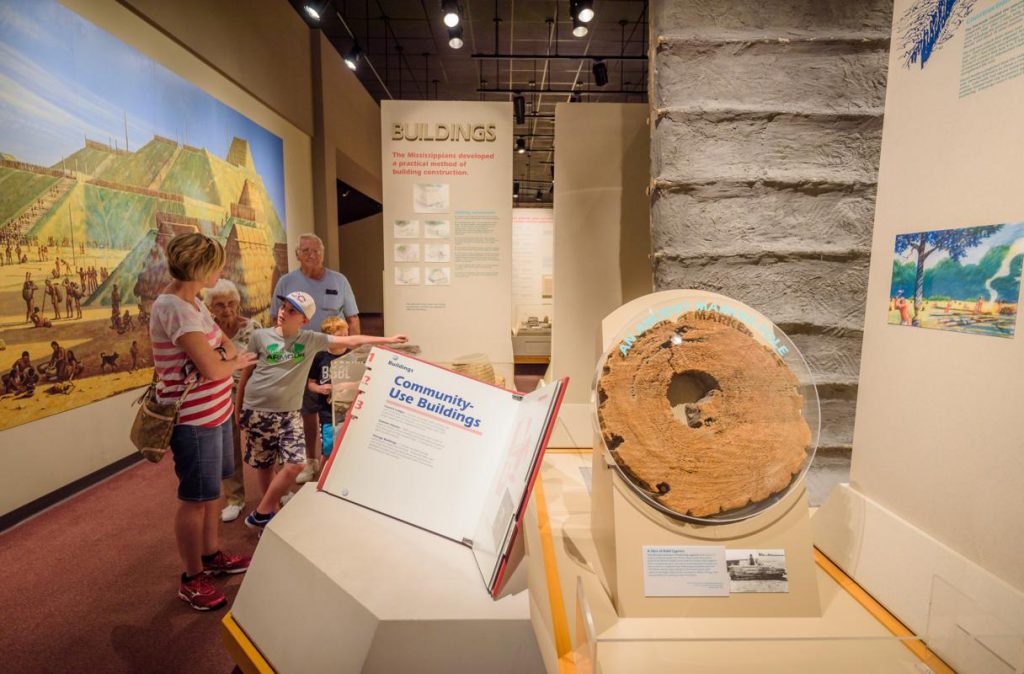
Cahokia Mounds State Historic Site
Before visiting the mounds and plazas via the walking trails, groups can peruse the impressive dioramas and other exhibits in Cahokia Mounds’ world-class interpretive center and see the 15-minute orientation film City of the Sun. Monks Mound, rising 100 feet, is the largest prehistoric earthen mound in the Americas and worth a hike to the top for views of the 2,200-acre archaeological site and fertile Mississippi River bottomlands that were farmed by the residents, who have been classified as members of the Mississippian culture. The flat-top platforms of this and other pyramids, used for ceremonies and as elite dwellings, were built to raise the rulers “closer to their brothers in the sky;” in some Mississippian societies, the chieftain was believed to be related to the sun and this may have been true at Cahokia.
Woodhenge, another key stop, is a reconstructed circular solar calendar with certain wooden posts aligning with the rising sun at the spring and fall equinoxes and the winter and summer solstices. Equinox and solstice sunrise observances are held on the Sunday morning closest to the event.
Head north through the Mississippi Valley and discover loads of Mormon history in Nauvoo, a small river town that attracts travelers from around the world. A pilgrimage site for Mormons seeking connections to their roots and their faith, Nauvoo preserves the remnants of the original Mormon settlement established in 1839 by Prophet Joseph Smith, founder of the Church of Jesus Christ of Latterday Saints. A living history complex called Historic Nauvoo is a collection of original and reconstructed homes and shops staffed by Mormon missionaries from various states; blacksmithing, baking, brick-making and other pioneer crafts are demonstrated. Narrated rides in a horse-drawn Conestoga wagon are available, as are ox wagon rides. The 20-minute film Remembering Nauvoo and other films are shown in the Historic Nauvoo Visitors’ Center.
For outdoor entertainment in summer at Historic Nauvoo, there’s the folksy variety show Sunset on the Mississippi and the Nauvoo Pageant, a tribute to Joseph Smith that alternates with the British Pageant, the story of Britons who converted to the LDS church and emigrated to America. The Young Performing Missionaries, a group of LDS church members from around the country, also do summer shows.
All sites, tours and shows at Historic Nauvoo are free. In town, the imposing Nauvoo Temple, dedicated in 2002 on the site of the original Mormon temple burned by vandals in 1848, is not open to visitors, but the Temple Arrival Center across the street has a 14-minute movie explaining the purpose of temples and showing many of the beautiful rooms.
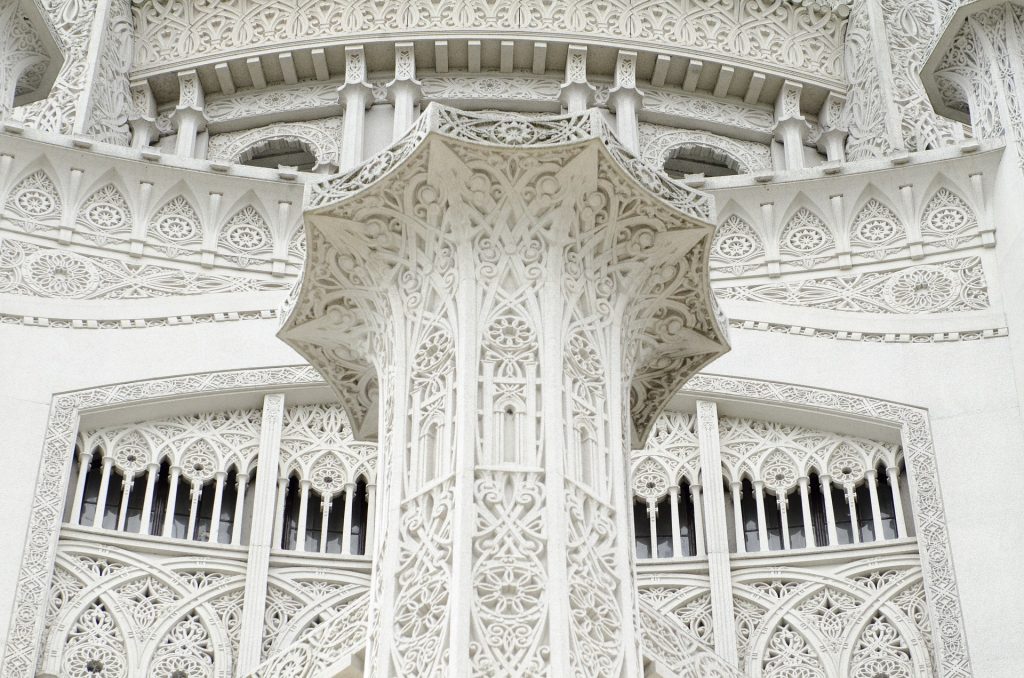
Bahá’í House of Worship
The Bahá’í House of Worship, better known as the Bahá’í Temple, is a landmark along the Lake Michigan shoreline in the northern Chicago suburb of Wilmette. A lacey, white, 135-foot-high dome enchants visitors to the first Bahá’í place of worship in the Western Hemisphere (completed in 1953) and one of only seven in the world. Like all Bahá’í temples, it is circular, has nine sides and is surrounded by fountains and gardens. The Bahá’í faith teaches tolerance, acceptance and peace, focusing on the oneness of God, oneness of humanity and oneness of religion. A movie in the welcome center tells the temple’s history. Group tours are available.
BAPS Shri Swaminarayan Mandir in west suburban Bartlett is the largest Hindu temple in North America. Built in 2004 with more than 7,000 tons of Turkish limestone and Italian Carrara marble, it dazzles visitors with its luminescent pinnacles, exotic domes, and photogenic fountains and gardens. Carved teak, shipped in whole pieces from India, decorate the temple (mandir) and adjacent Cultural Center, the starting point for tours. Inside the marble-and-granite place of worship are images of deities and intricately carved screens, pillars, ceilings and arches. The exhibition Understanding Hinduism sheds light on a religion practiced by one of every seven of the world’s people.
The most prominent temple in downtown Chicago is the Chicago Temple, as the First United Methodist Church, the oldest congregation in the city, is called. Located in the heart of the bustling Loop, right across from Daley Plaza and the iconic Picasso sculpture, the tallest church building in the world houses the exquisite Sky Chapel, a lofty perch under the spire of the 568-foot-tall, Neo-Gothic skyscraper built in 1924; tours of the chapel, accessible via two elevators and a set of stairs, are available. The chapel is a gift from the Walgreen family in memory of Charles R. Walgreen. Floors 5 through 21 are rented as offices.
The temple to see in suburban Oak Park is Frank Lloyd Wright’s Unity Temple, a masterpiece of 20th century architecture built in 1905 for a Universalist congregation (now Unitarian Universalist) that still occupies the building. Built of exposed concrete, the only surviving public structure from Wright’s Prairie period was perhaps the first house of worship to be constructed of a material reserved for factories and warehouses. Unity Temple, a National Historic Landmark, is included on architectural tours of Wright-designed buildings in Oak Park, home of the Frank Lloyd Wright Home and Studio.
The Billy Graham Center Museum, located on the campus of Wheaton College in the Chicago suburb of Wheaton, chronicles the history of Christian evangelism and spotlights the life and ministry of the Rev. Billy Graham, a 1943 graduate of the college. Displays trace the beginnings of evangelism in the New World, from the Spanish missionaries to the Pilgrims and Puritans from England. Vintage black-and-white newsreels depict Billy Sunday and other fiery speakers who drew crowds to specially constructed wooden tabernacles in the early 20th century. Asking attendees to commit to Jesus Christ, repent and give up alcohol, Sunday proclaimed, “We don’t need more grog, we need more God.”
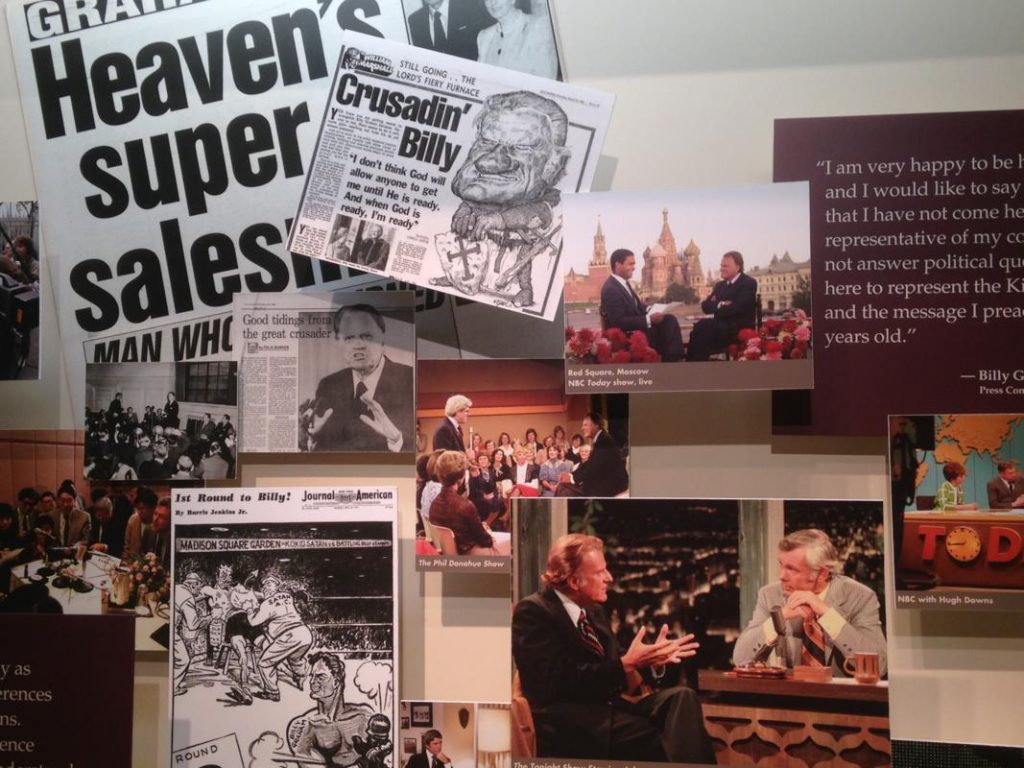
Billy Graham Center Museum
Credit: Randy Mink
In the Billy Graham galleries, visitors can stand at the traveling pulpit the late evangelist used on his Gospel-spreading crusades. Exhibits explain how the mass meetings were organized and show media coverage of Graham, the confidant of U.S. presidents and a frequent guest on TV talk shows. Videos recall campaigns in Los Angeles, London, New York and elsewhere.
Rockefeller Memorial Chapel is the spiritual and ceremonial center of another college, the University of Chicago, located in the city’s Hyde Park neighborhood. A gift from John D. Rockefeller, the 1928 Gothic church hosts carillon and organ recitals and also is known for its choral concerts. Tours of the carillon, accessible via 271 steps up a spiral stone staircase, afford fine views and the chance to see the bells played. The church’s interior features exquisite oak wood carving and a soaring vaulted ceiling decorated with mosaic tiles.
A survey of religious sites in Illinois is not complete without a mention of the glorious Catholic churches in Chicago, many of them easily accessible to visitors staying downtown. Just blocks from smart Michigan Avenue shops stands Holy Name Cathedral, the seat of the Roman Catholic Archdiocese of Chicago. Built in 1875, the grand limestone house of worship has a membership of 5,500 households and is the home parish of the archbishop, Cardinal Blase Cupich; tours are available. St. Peter’s in the Loop commands a prime location in Chicago’s central business district, while Old St. Patrick’s Church in the West Loop, commonly known as Old St. Pat’s, is the city’s oldest public building, dating from 1856. Holy Family Church, close to downtown, has served many ethnic groups over the years, most recently Mexican-Americans and African-Americans. One of Chicago’s most beautiful churches and its second oldest parish, the 1857 landmark, with its stained glass windows, sculpted wood statues and elaborately carved main altar, is one of the best examples of Victorian Gothic architecture in the U.S.
The state of Illinois certainly offers many places that provide divine inspiration, places that will make soul-nourishing stops on any group trip. Representing a variety of faiths, these religious sites will light the way and make your itinerary shine.
For more travel ideas, download our current issue of Leisure Travel Guide.


